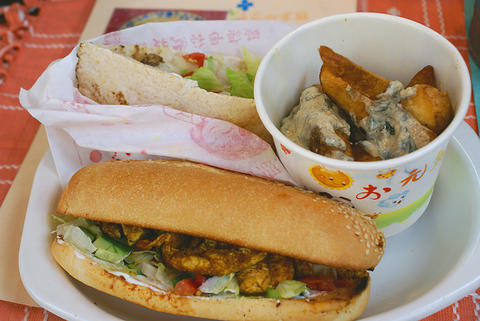The Taiwanese know how to use space - especially when it comes to small businesses. A quick wander through Ximending, Gongguan or Shida reveals that shopkeepers can and will use every available nook and cranny to sell anything from food or the latest clothing to knick-knacks and gewgaws. As storefronts go for a premium in these bustling areas, landlords are willing to rent every available ping to anyone who wants to try their luck.
Though some complain about overcrowding or - in the case of restaurant stalls - hygiene concerns, the consumer benefits from cheap food.
Take, for example, Biff's Pitas, a street stall that opened one month ago and has seen customers lining up to dig into some of the tastiest pitas in town. The owner, who calls himself Biff Cappuccino, is a Canadian who has lived in Scotland, Nigeria, Ireland, Uganda, the US and has spent the last two decades in Taiwan.

PHOTO: NOAH BUCHAN, TAIPEI TIMES
Biff's is located in front of an alley off Shida Road beside a Wellcome supermarket. There is no room for tables or chairs - besides a small space behind the grill for cutting chicken and fresh vegetables. Shida Park (師大公園) is right across the street. Low overheads mean paying low prices for healthy and delicious food.
"My father had a tradition where he would never cook the same meal twice in one month," Biff said. "He loved to experiment preparing foods from different countries." Though the menu at Biff's is fixed, he said he applied his father's ethos by experimenting with his cooking methods before arriving at his current creations, which reflect his interest in Asian flavors.
Five choices of filling are available for Biff's whole-wheat pitas: Madras curry chicken; Xinjiang cumin chicken; fennel seed chicken; Sichuan-style chicken; Mexico jalapeno chicken; and Thai tam yam chicken. One sandwich costs NT$55; two go for NT$100. Toppings include fresh cucumber, lettuce, onions, tomatoes, and a dollop of sour cream. The proprietor says he can make his sandwiches as spicy or mild as the customer wants.
My favorites are the Madras curry chicken and the Mexico Jalapeno chicken, extra spicy. The pitas are a bit on the small side but, at NT$55 for one, it's hard to complain. If one doesn't fit the bill, order a side of potato wedges (NT$35) or potato wedges with basil sauce (NT$50). If that isn't enough, order another pita.

On April 26, The Lancet published a letter from two doctors at Taichung-based China Medical University Hospital (CMUH) warning that “Taiwan’s Health Care System is on the Brink of Collapse.” The authors said that “Years of policy inaction and mismanagement of resources have led to the National Health Insurance system operating under unsustainable conditions.” The pushback was immediate. Errors in the paper were quickly identified and publicized, to discredit the authors (the hospital apologized). CNA reported that CMUH said the letter described Taiwan in 2021 as having 62 nurses per 10,000 people, when the correct number was 78 nurses per 10,000

As we live longer, our risk of cognitive impairment is increasing. How can we delay the onset of symptoms? Do we have to give up every indulgence or can small changes make a difference? We asked neurologists for tips on how to keep our brains healthy for life. TAKE CARE OF YOUR HEALTH “All of the sensible things that apply to bodily health apply to brain health,” says Suzanne O’Sullivan, a consultant in neurology at the National Hospital for Neurology and Neurosurgery in London, and the author of The Age of Diagnosis. “When you’re 20, you can get away with absolute

May 5 to May 11 What started out as friction between Taiwanese students at Taichung First High School and a Japanese head cook escalated dramatically over the first two weeks of May 1927. It began on April 30 when the cook’s wife knew that lotus starch used in that night’s dinner had rat feces in it, but failed to inform staff until the meal was already prepared. The students believed that her silence was intentional, and filed a complaint. The school’s Japanese administrators sided with the cook’s family, dismissing the students as troublemakers and clamping down on their freedoms — with

As Donald Trump’s executive order in March led to the shuttering of Voice of America (VOA) — the global broadcaster whose roots date back to the fight against Nazi propaganda — he quickly attracted support from figures not used to aligning themselves with any US administration. Trump had ordered the US Agency for Global Media, the federal agency that funds VOA and other groups promoting independent journalism overseas, to be “eliminated to the maximum extent consistent with applicable law.” The decision suddenly halted programming in 49 languages to more than 425 million people. In Moscow, Margarita Simonyan, the hardline editor-in-chief of the